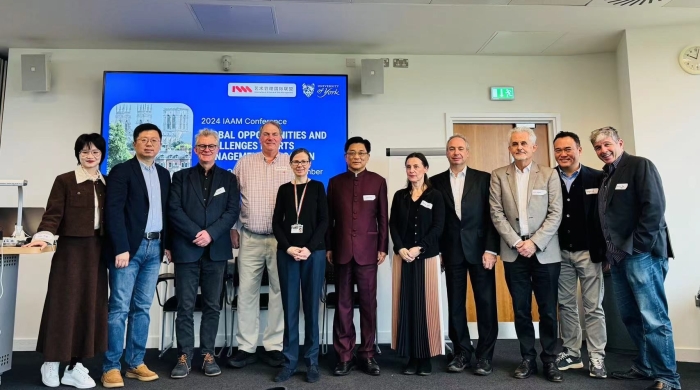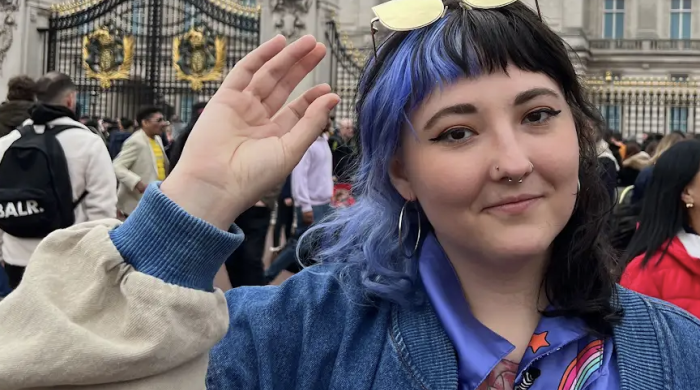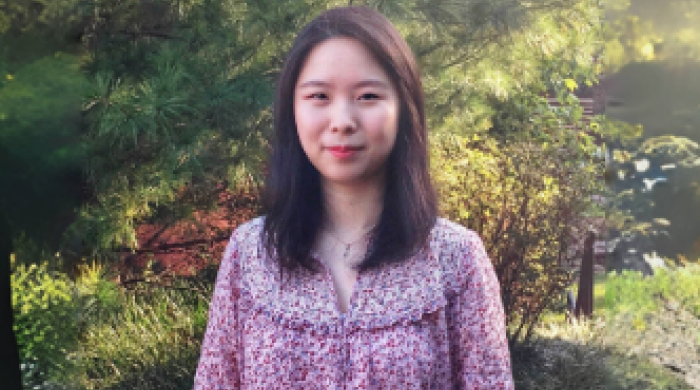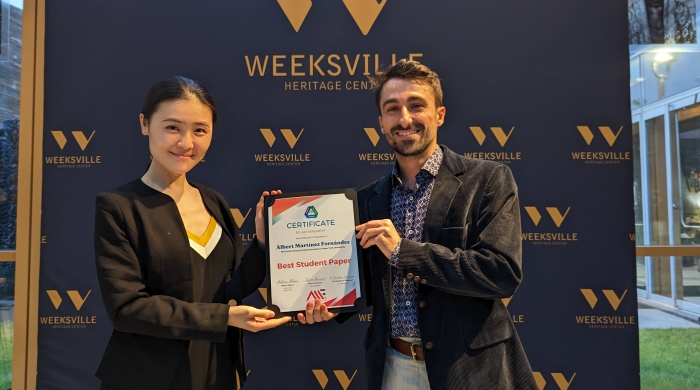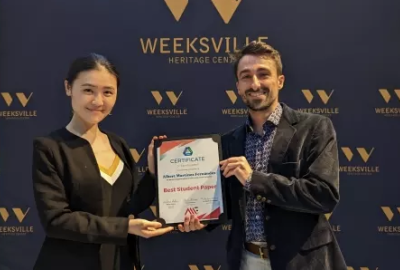
Scholarly News
PAA Faculty Share Research at International Alliance of Arts Management Conference
Dr. Richard Maloney and Dr. Ruby Yu engaged with global experts and scholars at IAAM 2024, presenting research on resilience, innovation, and educational opportunities that can shape the future of arts and cultural leadership.
Carol Seungwon Lee (PAA ’24) Published in Journal of Arts Management and More
Extending the life of a final project, Carol’s research on utilizing memorials as a performance space for the creative expression of cultural trauma and memory was published in an academic journal and presented at several conferences.
PAA Student Aubrey Mann Accepted into NYU’s EdD Program
Advancing to this prestigious practice-based doctorate program, Aubrey will explore audience care's limits in productions dealing with tough subjects.
NYU PAA Exhibits Academic Excellence Via Research Contributions
Recent PAA graduates published significant research in arts administration, fostering a community of researchers.
From NYU to New Horizons: Jiawen Wang (‘20) Pursues Sociology Ph.D.
Jiawen Wang excels beyond NYU's PAA, gaining a second master's at CUNY and pursuing a Ph.D. at Emory, deeply engaged in advancing cultural sector research.
PAA Faculty, Students, and Alumni Shine at AAAE Annual Conference
The Performing Arts Administration program was well represented at the Association of Arts Administration Educators’ (AAAE) annual conference on June 1-4, 2023.
Outstanding Research Recognition Class of 2025
-
Abstract
The arts industry in the United States has recently seen an uptick in worker unionization. Staff at Off-Broadway theaters such as Atlantic Theater (Miller, 2025) and visual arts organizations such as Dia Art Foundation (Velie, 2022) have voted to unionize for the first time in their organizations’ history. Additionally, a 2023 strike conducted by SAG-AFTRA and WGA emphasized the power of cross-union collaboration and coalition building in the arts (Fortmueller, 2024). However, despite significant increases in artist unionization and cross-union solidarity in the arts, creative workers continue to express fears about artificial intelligence technologies and their potential to disrupt future job security for artists, infringe on artists’ existing copyright, and threaten their rights to their own likeness (Andersen, 2023).This research addresses the role of coalition building and cross-union collaboration in protecting artists’ rights from artificial intelligence technologies. Utilizing the Human Artistry Campaign as a case study, this research assesses policy and bargaining outcomes achieved by coalitions of labor unions and cultural partners. The research also draws from interviews members of the Human Artistry Campaign, including Ned Hanlon, President of the American Guild of Musical Artists (AGMA); Tim Friedlander, Founder and President/Executive Director of the National Association of Voice Actors (NAVA); and Jennifer Roe, Executive Director of Folk Alliance International (FAI). Building upon Carola Frege, Edmund Heery and Lowell Turner’s definition of coalition building as a ‘secondary method’ of trade union organizing (Frege et al., 2004), I argue that coalitions are more necessary than ever in the current technological landscape.
-
Abstract
This study aims to fill the gap in empirical research by providing firsthand data and in-depth analysis of large-scale immersive performances. As immersive experiences continue to reshape audience engagement and expectations, there is a pressing need for transformation in traditional performances. Using Sphere Las Vegas as a case study, this research offers practical insights to guide these transformations.
Through covert participant observation of three distinct shows and semi-structured interviews with 16 audience members, the study provides valuable findings on: (1) how Sphere crafts immersive experiences, (2) how audience interactions differ in Sphere, and (3) the factors contributing to its commercial success. The findings emphasize the importance of multi-sensory experiences, active participation, and the cultivation of "flow" states in fostering deeper audience immersion. Additionally, the study explores the evolving dynamics of audience interactions with performers and each other, both in physical and virtual spaces. Finally, it investigates the impact of the Attention-Experience Economy on Sphere's commercial success. Based on these findings, the study offers practical suggestions for traditional performing arts to create more immersive and engaging experiences that align with evolving audience expectations.
-
Abstract
In an increasingly globalized world, cities are using arts festivals not only as cultural events but also as strategic tools for branding and global positioning. However, existing research often focuses on single-case studies and lacks comparative frameworks to analyze how different models of festivals contribute to city branding across varying cultural contexts.
This study aims to examine how arts festivals contribute to city branding by analyzing the China Shanghai International Arts Festival (CSIAF) alongside comparative cases such as SXSW, the Edinburgh Festival Fringe, the Wuzhen Theatre Festival, and the Aranya Theater Festival. It proposes a triangular model—Presence, People, and Pulse—to explain the multifaceted impact of arts festivals on a city’s image, community identity, and cultural vibrancy.
A detailed case study was used, focused on CSIAF. The study is guided by the City Brand Hexagon framework and focuses on three core dimensions—Presence (international visibility), People (community engagement), and Pulse (urban vibrancy). 1)Presence: CSIAF adopts a state-led model to project cultural soft power, while SXSW follows a market-driven approach grounded in creative industry innovation. 2)People: Festivals vary in how they engage communities: CSIAF uses a top-down approach, the Edinburgh Fringe empowers grassroots participation, and Wuzhen integrates local heritage with international performance. 3)Pulse: Urban vibrancy is enhanced through tourism-integrated programming , space reclaiming (Edinburgh), and lifestyle branding (Aranya). These findings show that festivals shape city branding through different mechanisms based on governance, space, and stakeholder participation.
This study contributes a practical and comparative model for understanding how arts festivals influence city branding. It offers new insights for arts managers and policymakers on how to align festival strategies with urban development goals. By integrating local identity, global positioning, and urban vibrancy, arts festivals can become powerful tools for sustainable and culturally resonant city branding.
-
Abstract
This project investigates the impact of the National Endowment for the Arts’ Challenge America grant on rural arts organizations and explores the consequences of its potential elimination. Through a multi-case study analysis of five rural organizations—spanning disciplines from climate theater to folk art festivals—this research reveals that even modest federal support plays an outsized role in sustaining rural cultural ecosystems. Findings highlight that Challenge America provides not only critical financial lifelines but also symbolic validation and institutional legitimacy to under-resourced communities. The study identifies cultural organizing—a practice already embedded in rural arts leadership—as a key strategy for resilience in the face of funding precarity. Ultimately, this work calls for policy shifts that recognize cultural organizing as essential to equitable rural development and recommends new funding models that center flexibility, community power, and cross-sector collaboration.
-
Abstract
South Korean licensed musicals have become an increasingly influential force in China’s growing musical theater market, offering a distinctive model of intercultural exchange. This thesis examines the localization adaptability of such productions through an in-depth case study of the Chinese adaptation of Fan Letter. By employing a mixed-methods approach, the research integrates quantitative data from 409 audience surveys, qualitative interviews with creative team members, and analysis of secondary sources.
To evaluate the adaptation’s effectiveness, a five-dimensional Localization Adaptability framework is proposed, encompassing: (1) Narrative & Cultural Recontextualization, (2) Dialogue, Lyric Translation & Auditory Compatibility, (3) Stage Direction, Choreography & Performative Interpretation, (4) Visual and Acoustic Design & Stagecraft Execution, (5) Market Integration & Audience Engagement.
The study makes a theoretical contribution by introducing and validating a multidimensional localization assessment model—one of the first in Chinese-language scholarship. Methodologically, it bridged audience reception, localization practices of the production team, and cultural adaptation theory through cross-analysis of diverse data sources. Practically, it identifies structural limitations in current localization practices and offers targeted, actionable recommendations for enhancing production processes, improving performance stability, refining market strategy, and enhancing audience retention. Together, these insights provide a strategic roadmap for improving the localization quality and long-term sustainability of Korean licensed musicals in China.
-
Abstract
Collaborations between non-profit and commercial theatre producers, most commonly through enhancement productions, play a crucial role in developing new theatrical work. However, these partnerships often expose tensions rooted in divergent goals, values, and processes. As enhancement deals become increasingly necessary amid rising production costs, shifting audience behavior, and changing funding structures, a deeper understanding of how these partnerships function is essential.
This thesis investigates the distinct skillsets that non-profit and commercial producers bring to enhancement collaborations and explores how these might be more effectively integrated to improve both efficiency and artistic outcomes. Informed by secondary data and grounded in existing literature, a theatre producer skillset model was developed to guide in-depth interviews with experienced New York City based producers from both sectors. The resulting interview transcripts were analyzed to identify and categorize 14 key producer skills across three domains:
- Skills utilized exclusively by non-profit producers in enhancement production processes;
- Skills shared by both non-profit and commercial producers in enhancement production processes;
- Skills that frequently cause friction due to conflicting institutional values.
By clarifying the roles, approaches, and contributions of each sector, this study offers practical recommendations for building stronger, more sustainable enhancement partnerships. The ultimate goal is that this research will support future efforts to establish a “relationship standard” for enhancement productions, offering a clearer framework for cross-sector theatrical development.

